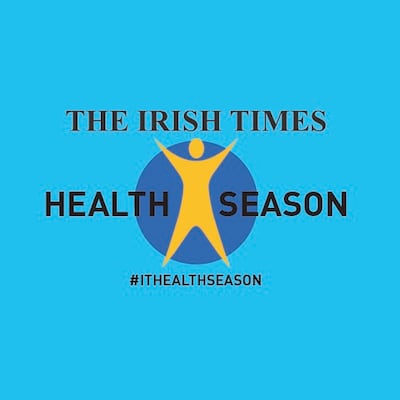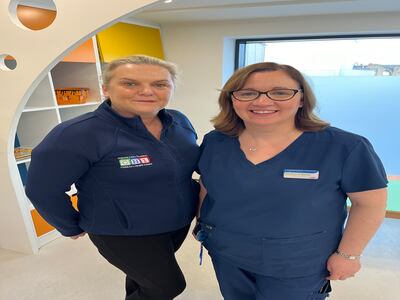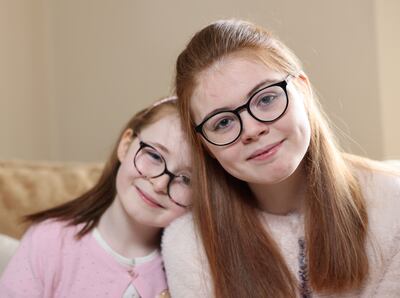The first signs of Rebecca Reid’s epilepsy were subtle, but came on suddenly when she was dancing in the kitchen at home, three days after her fifth birthday.

“She looked very slowly across the room,” recalls her mother Gráinne Reid. “I was trying to see what she was looking at – I actually thought she had seen a mouse.”
But when she went closer to her daughter, she thought Rebecca “looked dizzy, before she came out of it in a matter of five to six seconds”.
A few days later, the same thing happened, again during dancing, so Gráinne thought maybe she had just over-exerted herself. But after a third incident, when Rebecca was seated this time and her eyes started to flicker, her mother brought her to the GP. “It is quite a frustrating time for a parent because you know there is something not quite right, but there is nothing physically visible when you go to the doctor.”
RM Block
But unfortunately, very quickly, that was no longer the case, she says. Within the next week, Rebecca started to develop daily seizures, and they became more severe very quickly.
Rebecca, who is now aged 13, has had 9,339 recorded seizures since October 25th, 2016 up to the morning her mother spoke to The Irish Times. Documenting of the time, duration and type of seizure plays a vital role in first the diagnosis and then the management of epilepsy – or, to be more precise, of epilepsies, as there are different types and sub-groups.
[ Epilepsy: What is it and what does the future hold as treatments improve?Opens in new window ]
An estimated one in 200 children live with some form of epilepsy, which is a neurological disorder that affects the brain. Abnormal bursts of electrical activity result in seizures, which may be convulsive, ie, the body stiffens and muscles jerk, or non-convulsive, indicated perhaps by trance-like staring or a wandering episode. Medication may be effective in preventing seizures, or a child may grow out of them. However, epilepsy can develop at any age and is more common in older people, with an estimated one in 100 adults affected.

In her final year at primary school in Co Longford, Rebecca has very challenging, medically refractory focal epilepsy, which is resistant to medication. While she had a seizure-free period from January to September 2016, there has been no comparable break since, and the past 12 months have been particularly tough. “This week I know her daily average is seven seizures, and her monthly average is 145,” says Gráinne, who initially used pen and paper to keep seizure diaries. But last year, she and her partner Patrick moved to an Excel system, which either of them can access on their devices.
The need to keep Rebecca safe when a seizure happens is paramount in their daily lives. She doesn’t walk from the table to the chair without someone being present, ready to catch her if a seizure strikes. At school, there is always a special needs assistant (SNA) at her side. “She doesn’t toilet alone any more; she doesn’t shower on her own any more. She has no independence as a 13-year-old, which is heartbreaking for any mother.”
Yet through it all, Rebecca “is an amazing person, the most resilient person I know, and has a most beautiful attitude to life”, says her mother. Her younger sister, nine-year-old Emma, is an “absolute star” in the circumstances too.
With heightened emotion of any kind appearing to be a trigger for seizures, they have done a lot of emotion resilience work with Rebecca. It’s a case of “don’t get too happy, don’t get too sad, don’t get too angry”, explains Gráinne, who works for Tusla. “She loves reiki, reflexology and massage. As does mammy!”
It’s easy to tell parents “you have to mind yourself”, but that’s difficult to do. “It is not one of those things where you can say ‘Don’t worry about it, it may never happen’. It’s happening every day.”
With any normally developing child who has had a seizure, there is a 50:50 chance they are going to have another seizure in the next three years
All the data recorded on her daughter’s seizures enables Gráinne, in consultation with the neurology department of CHI@Temple Street in Dublin, to track Rebecca’s condition, looking for patterns that indicate triggers and her reaction to medication.
Siobhán O’Malley, the advanced nurse practitioner (ANP) for paediatric epilepsy at Temple Street, plays a huge role in the medical management of children such as Rebecca who are referred to the hospital. Her specialist training and masters qualification to become an ANP in 2020 means consultants can delegate new referrals for diagnosis and prescribing of certain medications to her. She will do a full neurological examination and can order further investigations. If she has any concerns or doubts she can involve the consultant.
She also provides all-important continuity of care, being readily available to families for regular phone consultations. “It’s a huge support. I would be lost without Siobhán,” says Gráinne, who becomes emotional in explaining just what a “crucial service” it is. As a mother, she feels empowered by the regular consultations, and O’Malley’s respect and encouragement in the sharing of ongoing details of her daughter’s condition.
“It’s valuing the input of parents [who] may not have studied it in college, but they are living it every single day and that information is crucial,” says Gráinne. She also speaks highly of the consultant paediatric neurologist, Dr Declan O’Rourke, who her daughter sees, usually twice a year at Temple Street. More straightforward cases than Rebecca may be managed solely by the ANP, who can offer a rapid access epilepsy clinic within a week of referral. This cuts out the waiting time for an appointment with a consultant neurologist.
“Some patients have been admitted and discharged through my service and have never seen a doctor,” says O’Malley, sitting in surprisingly smart and cheerfully renovated surroundings for a hospital that was founded in 1872. But her third-floor office window looks out towards dismal rooftop portacabins that housed the department up to about five years ago.

She takes more complex patients who may have been long attending a neurologist “under my wing because they may need additional support and care. They are regularly on the phone and need that extra bit of management. I can do that independently.”
O’Malley is one of about 100 ANPs working in specialities across the board in the Republic’s paediatric health services, but there are just three working in the area of epilepsy. “We are still nurses and don’t want to be doctors, but we are nurses with advanced skills and advanced training under the supervision of a medical mentor,” says O’Malley. The level of supervision reduces as the ANP builds up experience.
A child’s epilepsy is usually diagnosed after two or more known seizures. “You can have a diagnosis after one seizure if you have other risk factors – for instance, a child with cerebral palsy who has had a prolonged seizure.”
With any normally developing child who has had a seizure, there is a 50:50 chance they are going to have another seizure in the next three years, and it is that second seizure that will likely result in a diagnosis of epilepsy.
Febrile seizures, typically triggered by fevers, are not epilepsy. As symptoms of illness, they are “provoked” seizures, whereas epilepsy involves an “unprovoked” seizure.

With every new referral, “we literally put on our detective hats and we scrutinise the story”, says O’Malley. She will conduct a phone triage first, delving into what has happened, where, when and how. Sometimes, they may turn out to have been harmless faints with a few jerks. Depending on the type of seizure reported, she might very quickly want to see the child or to order an electroencephalogram (EEG), which measures the electrical activity of the brain.
However, somebody with epilepsy can have a normal EEG; likewise, an abnormal EEG may not be epilepsy, says Ann Connolly, who is O’Malley’s counterpart at CHI@Tallaght and joined us in Temple Street for the interview. She was the first ANP to qualify to work in paediatric epilepsy. There is a third, Gráinne Griffen, at CHI@Crumlin, with a fourth person being trained for a similar role in Cork University Hospital.
“We often ask people to video the child’s seizures,” says Connolly, acknowledging that initially some parents or teachers might think this inappropriate. But such evidence is highly valuable for giving clues to the type of epilepsy involved and the kind of medication needed.
[ Epilepsy gene research hailed as ‘significant step’ in understanding conditionOpens in new window ]
However, whipping out a phone camera is unlikely to be a parent’s response the first time they witness a seizure. Parents are very fearful, agrees O’Malley – “a lot of what we do is managing the fear”. Explaining what is happening to their child’s body, why their muscles are jerking, why they turn blue, can help to reduce anxiety.
Individuals living with epilepsy and their families would like everyone to know how to respond to somebody having a seizure, which could happen any time, anywhere. The advocacy charity Epilepsy Ireland, which uses International Epilepsy Day on February 12th each year to raise public awareness, sums up first aid for seizures in three words:
Time: The first thing to do is time the seizure, because if it lasts more than five minutes, an ambulance must be called.
Safe: Keep the person safe, removing potentially harmful objects in the vicinity and cushioning their head with something soft if possible. However, don’t restrain them and don’t put anything in their mouth in the mistaken belief that they might swallow their tongue. They won’t.
Stay: Remain with the person for as long afterwards as it takes for them to recover. Explain what happened and reassure them, as a seizure may leave them confused and often exhausted.
Parents and SNAs working with children with long-term epilepsy are trained on how to intervene if a seizure lasts more than five minutes. They are equipped with an pre-loaded oral syringe containing a gel which is then delivered into the side of a child’s mouth and should stop the convulsions.
In very rare cases, seizures can cause death or result in a fatal accident. The ANPs say they are having much more open conversations now with families about what is known as “sudden unexpected death in epilepsy”.
Although she was right beside Rebecca when a seizure hit, she wasn’t able to save her from hitting her head off the edge of a pillar, cutting her forehead open
Connolly says that sometimes parents ask her about this directly; other times she will raise the topic so she can give a balanced explanation, as otherwise she knows they will search for it on the internet. “Sometimes it will be a child going to sleep and not waking up the next morning.”
The sudden death may not have involved a convulsive seizure and there are still a lot of unknowns around this cessation of life. Parents and patients will be talked through risk factors, such as not taking medications, and that boys have a higher incidence of seizures in their sleep.
Typically, most types of seizures don’t seem to damage the brain. However, O’Malley says they do know long-term, frequent seizures can have an impact on a person’s mood and ability to learn and concentrate. She and Connolly also do a lot of work with families on safety around seizures. Affected children are advised, for instance, not to ride bicycles or electric scooters; sea swimming is too dangerous, as is being in a pool, or even a bath, if unsupervised. They can’t climb heights, in case they fall.
Despite all the challenges of Rebecca’s condition, Gráinne insists that “life is for living”, and they still try to do plenty of activities, both at home and on outings with extended family and understanding friends. Christian faith is important to them. Gráinne plays the organ in a local church in Ardagh and Emma is learning to play it too, while Rebecca sings in the choir – with ever-watchful singers on either side. Very seldom does she get any warning a seizure is coming, although occasionally she might have a momentary sensation that gives her time to sit down.

Although everything they do as a family requires high levels of planning, even then, incidents will happen.
On a pre-Christmas shopping trip, Gráinne gave both her daughters a few minutes to spend some pocket money in a discount shop. Although she was right beside Rebecca when a seizure hit, she wasn’t able to save her from hitting her head off the edge of a pillar, cutting her forehead open. The shop staff handled it very well, but Rebecca had to go to the hospital emergency department and “obviously that has an impact on her, an impact on her sister”.
When it was just too difficult to get her daughter to pre-Christmas choir practices, the choir came to their home. “What Rebecca can’t go to, we bring to her.”
Having been through about 15 failed medications, she has had medicinal cannabis, CBD, added to her twice-daily cocktail of drugs since last November. While research indicates there isn’t a high success rate for Rebecca’s type of epilepsy, says Gráinne, “We have to keep trying something”.
She had 200 seizures in November, and while this was down to 100 in December, these were longer and more severe. There were also side effects – headaches, pains in her tummy – but they have begun to subside and, as her daughter’s appetite returns, she expects the dose of CBD will be increased. “I am hopeful it will work, but at the same time you can’t be over-optimistic.”
However, she is encouraged by rapidly evolving scientific knowledge about epilepsy, and is so grateful for all those who do fundraising for such research because “this could be life-changing” for children such as Rebecca. “Without seizures, she is your normal, typical 13-year-old girl. Yet, her life is so hampered because of the threat of a seizure.”
- Sign up for push alerts and have the best news, analysis and comment delivered directly to your phone
- Find The Irish Times on WhatsApp and stay up to date
- Our In The News podcast is now published daily – Find the latest episode here






















